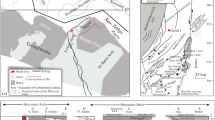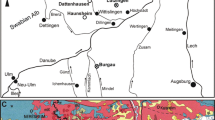Abstract
The early Mesoproterozoic Rohtas Limestone in the Son valley area of central India represents an overall shallowing-upward carbonate succession. Detailed facies analysis of the limestone reveals outer- to inner-shelf deposition in an open marine setting. Wave-ripples, hummocky cross stratifications and edgewise conglomerates argue against a deep marine depositional model for the Rohtas Limestone proposed earlier. Stable isotope analysis of the limestone shows that δ13C and δ18O values are compatible with the early Mesoproterozoic open seawater composition. The ribbon limestone facies in the Rohtas Limestone is characterized by micritic beds, each decoupled in a lower band enriched and an upper band depleted in dissolution seams. Band-wise isotopic analysis reveals systematic short-term variations. Comparative enrichment of the heavier isotopes in the upper bands is attributed to early cementation from sea water and water derived from the lower band undergoing dissolution because of lowering of pH at depth. The short-term positive shifts in isotopic compositions in almost every upward gradational transition from a seamed band to a non-seamed band support the contention that dissolution seams here are of early diagenetic origin, although their formation was accentuated under overburden pressure.
Similar content being viewed by others
References
Aharon P and Liew T C 1992 An assessment of the Precambrian/ Cambrian transition events on the basis of carbonate isotope record. In: Early Organic Evolution: Implications for Minerals and Energy Resources (eds) M Schidlowski, S Golubic, M M Kimberley, D M Mc Kirdy and P A Trudinge (Berlin: Springer-Verlag), Pp. 211–223.
Allan J R and Mathews R K 1982 Isotope signatures associated with early meteoric Diagenesis;Sedimentology 29 797–817.
Allen J R L 1982 Sedimentary structure, their characters and physical basis. Vol. II. Developments in Geology, Chap 30 B (Amsterdam: Elsevier), Pp. 663.
Auden J B 1933 Vindhyan sedimentation in Son valley;Geol. Surv. Ind. Mem. 62 141–150.
Ball D F 1976 Close-packed patterned arrangements of stones and shells on shore-line Platforms;Biul. Peryglac. 25 5–7.
Banerjee S 1997 Facets of the Mesoproterozoic Semri Sedimentation in Son valley, India. Unpubl. Ph.D. thesis, Jadavpur University, Kolkata, p. 137.
Banerjee S and Schieber J 2003 Paleoproterozoic condensed zone sediments in the Kajrahat Formation, Vindhyan Supergroup, central India; Geological Society of America Abstracts with programs, November 2–5, Seattle,35, Abstract No. 64226.
Bathurst R G C 1987 Diagenetically enhanced bedding in argillaceous platform limestones: stratified cementation and selective compaction;Sedimentology 34 749–778.
Beeunas M A and Kanuth L P 1985 Preserved stable isotope signature of subaerial diagenesis in the 1.2 b.y. Mescal Limestone, central Arizona: implication for the timing and development of a terrestrial land plant cover;Geol. Soc. Am. Bull. 96 737–745.
Bose P K, Sarkar S and Bhattacharya S K 1996 Dissolution seams: some observations from the Proterozoic Chanda Limestone, Adilabad, India;Carbonates sand Evaporites 11 70–76.
Bose P K, Sarkar S, Chakraborty S and Banerjee S 2001 Overview of the Meso- to Neoproterozoic evolution of the Vindhyan basin, central India;Sed. Geol. 141 395–419.
Burdett J W, Grotzinger J P and Arthur M A 1990 Did major changes in Proterozoic seawater occur?Geology 18 227–230.
Byers C W and Stasco L E 1978 Trace fossils and sedimentologic interpretations -Mc Gregor Member of Plateville Formation (Ordovician) of Wisconsin;J. Sed. Pet. 48 1303–1309.
Chakraborty P P, Sarkar A, Bhattacharyya S K and Sanyal P 2002 Isotopic and sedimentologic clues to productivity changes in the Late Riphean sea: a case study of two intracracratonic basins of India;Proc. Indian Acad. Sci. (Earth Planet. Sci.) 111(4) 379–370.
Chakraborty P P 2004 Facies architecture and sequence development in a Neoproterozoic carbonate ramp: Lakheri Limestone Member, Vindhyan Supergroup, Central India;Precamb. Res. 132 29–53.
Chakraborty T, Sarkar S, Chaudhary A K and Das Gupta S 1996 Depositional environment of Vindhyan and other Purana basins: a reappraisal in the light of recent findings. In: Recent Advances in Vindhyan Geology (ed.) Bhattacharyya A,Mem. Geol. Soc. Ind. 36 101–126.
Chanda S K and Bhattacharyya A 1982 Vindhyan sedimentation and paleogeography: post-Auden developments. In: Geology of Vindhyanchal (eds) K S Valdiya, S B Bhatia and V K Gaur (Hindusthan Publishing Corporation: Delhi), Pp. 88–101.
Chatterjee B K and Sen P K 1988 Spectral analysis of a Precambrian limestone-shale sequence, Lower Vindhyan, India;Precamb. Res. 39 139–149.
Craig H 1957 Isotopic standards for each carbon and oxygen correlation factors for mass spectrometric analysis of carbon dioxide;Geochim. Cosmochim. Acta 12 133–149.
Dean W E 1974 Determination of carbonate and organic matter in calcareous sediments and sedimentary rocks by loss on ignition: comparison with other methods;J. Sed. Pet. 44 242–248.
De Raaf J F M, Boersma J R and Vangelder A 1977 Wavegenerated structures and sequences from a hallow marine succession, Lower carboniferous County Cork, Ireland;Sedimentology 24 451–483.
Dionne J 1971 Vertical packing of flat stones;Can. J. Earth Sci. 8 1585–1591.
Dott R H Jr and Bourgeois J 1982 Hummocky cross stratification: significance of its variable bedding sequences;Bull. Geol. Soc. Am. 93 663–680.
Eder F W 1982 Diagenetic redistribution of carbonate, a process in forming marl-limestone alternations (Devonian and Carboniferous), Rhenisches Schiefergebrige, W. Germany. In: Cyclic and Event Stratification (eds) G Einsele and A Seilacher (Berlin: Springer-Verlag), Pp. 93–124.
Enos P 1977 Tamabra Limestone of the Poza Rica Trend, Cretaceous, Mexico;Special Publ. Soc. Econ. Paleont. Miner. 25 273–314.
Friedman G M, Chakraborty C and Kolkas M M 1996 Excursion in the end-Proterozoic strata of the Vindhyan basin (central India): its chronostratigraphic significance;Carbonates and evaporites 11 206–212.
Hall S M and Veizer J 1996 Geochemistry of Precambrian carbonates.VII. Belt Supergroup, Montana and Idaho, U.S.A;Geochim. et Cosmochim. Acta 60 667–977.
Hampton M A 1975 Competence of fine grained debris flows;J. Sed. Pet. 45 834–844.
Hoffman P F, Kaufman A J, Halverson G P and Schrag D P 1998 A Neoproterozoic snowball earth;Science 281 1342–1346.
Hudson J D 1977 Stable isotopes and limestone lithification;J. Geol. Soc. London 133 637–660.
Kaufman A J and Knoll A H 1995 Neoproterozoic variations in the C-isotopic compositions of the seawater: stratigraphic and biogeochemical implications;Precamb. Res. 73 27–49.
Knoll A H, Hayes J M, Kaufman A J, Swett K and Lambert I B 1986 Secular variations in carbon isotope ratios from Upper Proterozoic successions of Svalbard and East Greenland;Nature 321 832–838.
Knoll A H and Swett K 1990 Carbonate deposition during the late Proterozoic era: an example from the Spitsbergen;Am. J. Sci. 290A 104–132.
Kumar B, Das Sharma S, Sreenivas B, Dayal A M, Rao M N, Dubey N and Chawla B R 2002 carbon, oxygen and strontium isotope geochemistry of Proterozoic carbonate rocks of the Vindhyan basin, central India.Precamb. Res. 113 43–63.
Li Z and Komar P D 1986 laboratory measurements of pivoting angles for applications to selective entrainment of gravel in a current;Sedimentology 33 413–423.
Lindsay J F and Brasier M D 2000 A carbon isotope reference curve for 1700-1575 Ma, Mc Arthur and Mt Isa Basins, northern Australia.Precamb. Res. 99 271–308.
Mount J F and Kidder D L 1993 Combined flow origin of edgewise intraclast conglomerates: Sellick Hill Formation (Lower Cambrian), South Australia;Sedimentology 40 315–329.
Postma G, Nemec W and Kleinspehn K L 1988 Large floating clasts in turbidites, a mechanism for their emplacement;Sedi. Geol. 58 47–61.
Rasmussen B, Bose P K, Sarkar S, Banerjee S, Fletcher I R and Mc Naughton N J 2002 1.6 Ga U-Pb zircon ages for the Chorhat Sandstone, Lower Vindhyan, India: possible implication for early evolution of animals;Geology 30 103–106.
Ray J S, Martin M W and Veizer J 2002 U-Pb zircon dating and Sr isotope systematics of the Vindhyan Supergroup, India;Geology 30 131–134.
Ray J S, Veizer J and Davis W J 2003 C, O, Sr and Pb isotope systematics of carbonate sequences of the Vindhyan Supergroup, India: age, diagenesis, correlation and implications for global events;Precamb. Res. 121 103–140.
Sarangi S, Gopalan K and Kumar S 2004 Pb-Pb age of earliest megascopic eukaryotic alga bearing Rohtas Formation, Vindhyan Supergroup, India: Implications for Precambrian atmospheric oxygen evolution;Precamb. Res. 132 107–121.
Sarkar S, Chakraborty P P and Bose P K 1996 Proterozoic Lakheri Limestone, central India: facies, paleogeography and physiography. In: Recent Advances in Vindhyan Geology (ed.) Bhattacharyya A,Mem. Geol. Soc. Ind. 36 5–25.
Schidlowski M 2001 Carbon isotopes as biogeochemical recorders of life over 3.8 Ga of earth history: evolution of a concept.Precamb. Res. 106 117–104.
Schieber J 1999 Microbial mats in terrigenous clastics: the challenge of identification in the rock record;Palaios 14 3–12.
Sepkoski J J Jr 1982 Flat-pebble conglomerates, storm deposits and the Cambrian bottom fauna. In: Cyclic and Event Stratification (eds) G Einsele and A Seilacher (Berlin: Springer-Verlag), Pp. 371–385.
Shields G and Veizer J 2002 Precambrian marine isotope database: Version 1.1;Geochem. Geophys. Geosys. 3 U1-U12.
Singh I B 1973 Depositional environment of the Vindhyan sediments in the Son valley area; Recent Researches in Vindhyan,Geology 1 140–152.
Snedden J W, Nummedal D and Amos A F 1988 Stormand fair-weather combined flow on the central Texas continental shelf;J. Sed. Pet. 58 580–595.
Tucker M E 1982 Storm-surge sandstones and the deposition of interbedded limestone: late Precambrian, southern Norway. In: Cyclic and Event Stratification (eds) G Einsele and A Seilacher (Berlin: Springer-Verlag), Pp. 363–370.
Author information
Authors and Affiliations
Rights and permissions
About this article
Cite this article
Banerjee, S., Bhattacharya, S.K. & Sarkar, S. Facies, dissolution seams and stable isotope compositions of the Rohtas Limestone (Vindhyan Supergroup) in the Son valley area, central India. J Earth Syst Sci 114, 87–96 (2005). https://doi.org/10.1007/BF02702011
Received:
Accepted:
Issue Date:
DOI: https://doi.org/10.1007/BF02702011




